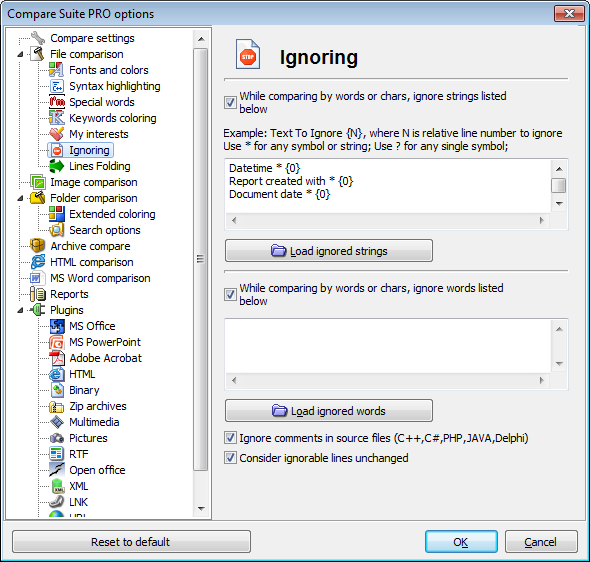

To do this, use the pattern column_name:value in You can also filter by a particular column of the view. The table is instantly "filtered down" to the rows that contain the filter character string
BEYOND COMPARE IGNORE LINE ENDINGS HOW TO
How to export the content of the current table view to a text file in CSV (Comma Separated Values) or XML format, The Export view data button, existing in some views, opens a new window that configures It instead sorts the entries in each directoryĮxporting the table contents to a text file Sorting on the Item column doesn't disturb the directory hierarchy. Clicking it again reverses the sort order. You can drag the right-hand separator line of any column to adjust the column width - all the way down to nothing,ĭouble-clicking a right-hand separator line resizes the column to the width of the largest element.Ĭlicking a column header sorts the rows on that column. Modify the current block by moving the "free" row upward or downward. Shift + Down-Arrow Similar to Shift + Left-Click: Keyboard gestures Up-Arrow and Down-Arrow Discard the current selection set, if any, and move the selection highlight upward or downward. If the current selection set consists of a non-consecutive set of rows, that selection set is discarded. Keeping the same "anchor" row but changing the "free" row. If there is already a block of consecutive rows selected this way, extend (or invert) the selection by To the row you are clicking now (the "free" row). Select the block of consecutive rows that extends from the row you clicked most recently (the "anchor" row) Ctrl + Left-Click Toggle the membership of the clicked row in the set of selected rows. Mouse gestures Left-Click Select a single row, which represents a single SCM object. The GUI recognizes the "standard" single-selection and multiple-selection gestures supported by many graphical You can manipulate these tables by using some common operations: The table columns contain values of the objects' fields, like Name, Status, Creation Date.


Many of the GUI's views are tables or include a table and other elements.Įach table row represents one SCM object, like an item, a revision, a branch. How to manage objects in the Plastic GUI views To show or hide the help panel as you want. You can also click the Information button in each view (which looks This help system is a starting point to improve onboarding usability and help users becomeĮxperts on version control in an active way. This smart and methodic librarian that aligns well with the Plastic philosophy: preserve This help system comes with a good amount of art in the form of a mascot - our wise If you've never colored your Branch Explorer based on the authors of the changesets, the help Probably why you can't find what you're looking for: The GUIs will detect this and show a panel telling you that you have a filter set, and that's Suppose you have a filter in the view preventing you to see what you are looking for. Suppose you frantically click the "refresh" button of the Changesets view. It is better explained with some examples: It is implemented as a panel in all views that shows up to help you discover new features or respond to things that might be causing frustration. Help that guides you while you learn how to master Plastic SCM. It's a mix of UX improvements with empty states and a smart Each time a view is opened using the buttons in the left panel, a new tab is created, or the existing tab is activated if it was previously open.

If you switch back to the original workspace - in the same GUI session or in a subsequent one - its work context is restored exactly as you left it. When you switch the active workspace, the GUI preserves the current state of the work context. It can include any number of tabbed windows, called views. The main portion of the GUI window is a region that displays the active workspace's work context. Once you open a workspace (active workspace), all its related information appears just below: This is called the active workspace - it's like the current working directory in a command processor. Turn, and the expansion is the resultant list.The Plastic SCM GUI window is structured around the fact that you can have any number of workspaces, but you work with one workspace at a time. Removal operation is applied to each member of the array in If param‐Įter is an array variable subscripted with or *, the pattern Ter in turn, and the expansion is the resultant list. Pattern removal operation is applied to each positional parame‐ Matching pattern (the ``#'' case) or the longest matching pat‐ The beginning of the value of parameter, then the result of theĮxpansion is the expanded value of parameter with the shortest The word is expanded to produceĪ pattern just as in pathname expansion. Remove the last part $ asdf="xxx/xxxx/xxxxx/yyy" You can use parameter expansion in bash, in this case


 0 kommentar(er)
0 kommentar(er)
